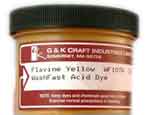What do you think it would take to dye a nylon parachute?
Name: Travis
—ADVERTISEMENT—
Washfast Acid dyes
at Paradise Fibers

Washfast Acid dyes
Also known as Nylomine dyes, excellent for use on nylon. One ounce of dye will dye six pounds of fiber!
at Paradise Fibers

Washfast Acid dyes
Also known as Nylomine dyes, excellent for use on nylon. One ounce of dye will dye six pounds of fiber!
Message: What do you think it would take to dye a nylon parachute?
It would take a huge quantity of acid dye, plus a truly vast cooking pot (or dyeing machine) so that you can heat the nylon in the dye.
Uncoated nylon, if it is free of oils and other finishes or contaminants, is easy to dye with almost any acid dye, in the presence of a mild acid such as vinegar, but heat is required for the best results. It's hard to imagine a container large enough to immerse a parachute; how big do you think it would have to be, in volume?
Among the best dyes for nylon are the Nylomine dyes, many of which are also sold in PRO Chemical & Dye's line of WashFast Acid Dyes. Most other acid dyes, which are dyes intended for use on wool, will also work on nylon, because nylon, like wool, is a polyamide fiber. See my page, "How to dye nylon or polyamide".
Some dyeing of the nylon can take place in merely hot water, such as in a washing machine, but you'll still have to immerse it. Can you find a container large enough to immerse it, and a source for that large a quantity of hot water? Will it fit in an ordinary washing machine, or will you have to find a much larger commercial machine?
If you airbrush or spray a huge piece of clean nylon with acid dye, you can wrap it up and then steam it, in a large pot or some industrial equivalent, to set the dye. Moisture is required during the heat-setting process, for any true dye. If you use dry heat, you must keep the nylon wet with the dye; dry dye will work only if moisture from the steam can contact every bit of the nylon.
To commercially dye a large piece of nylon, you can contact one of the custom dyeing companies listed on my page entitled "Where can I find someone to dye my clothing for me?". Not all dyers are interested in dyeing synthetic materials such as nylon, but many more will dye nylon than will try dyeing polyester.
Alternatively, and again only if the nylon is free of any sort of oil or other surface finish (waterproofing makes it impossible to dye), you can use fabric paint to "pigment dye" nylon. Don't use ordinary artists' acrylic paints, or house paints, because these will produce a stiff and scratchy surface, and will not stick to the fabric as well. You can add a product called "fabric medium" to acrylic paint to turn it into fabric paint, or you can buy fabric paint in jars. I recommend you buy from suppliers that can sell you gallon-sized jars of fabric paint, not just the little 8-ounce jars (which many crafts stores carry). Dharma Trading Company sells several different fabric paints that are recommended by their manufacturers for synthetic as well as natural fibers.
In addition to being concerned about whether there are any oils or other contaminants on the nylon that will block the action of your dye or paint, you also should be concerned as to whether your material is truly nylon. My mother bought yarn that was sold as "parachute silk" which turned out to be not silk, and not nylon, but rayon, which is a cellulose fiber, and which dyes completely differently than nylon. Polyester is another possibility, much more difficult to dye than nylon. To determine the fiber content, you may snip off a tiny bit of material and carefully subject it to a burn test. Two excellent resources for interpreting the results of a fiber burn test are Griffin Dyeworks' Burn Test page and Ditzy Prints' Fiber Burn Chart.
To determine whether there are finishes on the nylon that will cause problems, you will probably have to do a test dyeing. Unfortunately, these are very common, so common that it's best to look for sources of PFP nylon ("Prepared For Printing") to avoid this problem, probably not possible for a parachute. In some cases unwanted finishes can be removed by washing in very hot water (140°F) with soda ash and detergent, but in many cases these finishes cannot be removed at all.
(Please help support this web site. Thank you.)
Posted: Tuesday - June 09, 2009 at 09:42 AM
Follow this blog on twitter here.
Quick Links
- All About Dyes & Dyeing Top -
- Top of this blog -
- FAQ -
- The Dye Forum -
- How to Tie Dye - How to Batik -
- Books - Toys - Plants -
- Top of this blog -
- FAQ -
- The Dye Forum -
- How to Tie Dye - How to Batik -
- Books - Toys - Plants -
More in this category:
- -
Statistics
Total entries in this blog:
Total entries in this category:
Published On: Aug 29, 2012 02:48 PM
Total entries in this category:
Published On: Aug 29, 2012 02:48 PM